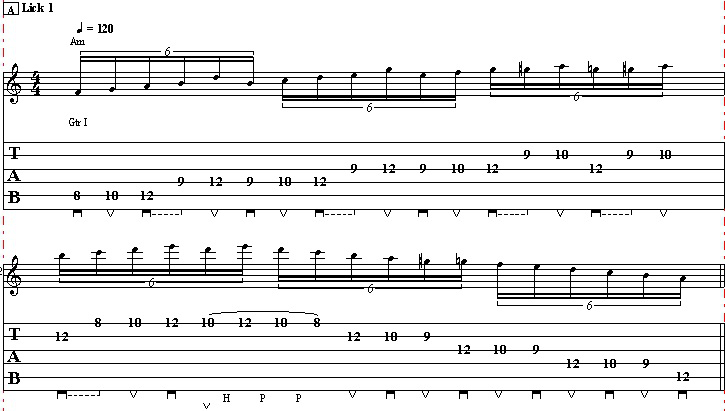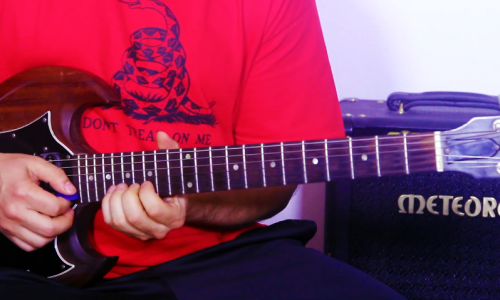Hey, how’s it going Sean Daniel with Guitar Control, today we’re learning an awesome Neo-Classic, if you wanna look at it that way, it’s called “Old Enough” by the Raconteurs. A really cool song because it involves a lot of acoustic guitar chords, but with a really cool riff.
[ninja-popup ID=715]
Click on the Tabs button to follow chords and tabs.
So basically, it sounds a little bit like this. So, that’s kind of the main verse bar, which we’re going to get to the whole part, but I want to start right there. And let’s actually start with the riff because this is really just a riff that is kind of built around an F major chord. So if you look at just the riff, it sounds like this. Now, most of the verses start with this D major chord, so this is going to lead us into the D major chord. So we’re kind of learning it riff first and then backwards. But, it’s a really fun riff because it’s easy to play and it sounds cool. Makes it seem like you’re doing something more impressive than you actually are, which is really the hallmark of just a good riff. So we got here, the 3rd fret of the D-string which is an octave F. This is an F note.
And this is all happening in the 3rd fret and the 2nd fret as you’ll see. So we have three D to 2D. And notice I’m using my middle finger and my pointer finger. You don’t wanna use the same finger because we’re going to do a hammer-on pull-off in a second. So, 3D, 2D, to the A-string 3-2-3. And then, 2-3-2. Hand up on that G note, the 3rd fret of the low E- string. And then go to a D major chord. So this riff reset the chord structure a little bit, and then it goes to the main chord part which is really just a D to a C, and a G.
This really could be like a million different songs, but, this is a Raconteurs song. Start with a D major chord, middle finger, 2nd fret on the high string, 3rd fret ring finger B-string, pull your finger, 2nd fret G-string. Now really you’re going to your ring finger on the 3rd fret of the B-string, this isn’t going to move at all for entire verse, We’ve got a D, C, G, D. Now this is really a Cadd9, it isn’t just a C major, it’s a C with a D note. Now sometimes, the official name of this chord is a Cadd9. Sometimes on a chord chart you’re see it as C-2 or something because really D is just the second note in the C major scale or the 9th note. Again, music theory isn’t really so important for this song. But the strumming patterns really cool. So it’s like, D, to C, to G.
Now if you look at my hand, my strumming hand, it’s just kind of going back and forth, alternating and then your fretting hand really controls a lot of it.
Now if I were going to talk about it directionally. Down, down, up, down. Down, down, up, down. So D kind of has it’s own it stop spot in the bar and C and G share a spot in the bar, 1-2-3-4, 1-2-3-4, 1-2- and 3-4, 1-2-3-4, 1-2 and 3-4, 1-2- and 3-4. Down, down, up, down, down. Down, down, up, down, down. However many variations you wanna add, that’s the main groove of the entire song.
Now you’ll notice when I’m doing it. You’ll see that I’m leaving the chord. My ring fingers staying here, but to by myself time. To get to that C and the G chord, you can actually just off in an open string set and then come down on the chord, it’s going to sound fine, right. So it’s always more important to be steady with your strumming hand, than arrive to chord on time with your fretting hand. Now again, they’re both important, but as long as you keep a steady strumming, if you’re just a little bit late. You can kind of make it work, right. So the timing is super important, but really, the entire verse is just D, to C, G. D, Cadd9 to G. D, to C to G. To the riff.
Again so that’s a good portion of the song. From here we can go to the other portion song, which is an F. To a C, F to C, to D, to G, D, G, F to C, F to C, then back to D. With a little bit of a riff in there. So let’s talk about this. Now they’re evenly split, we have an F major chord. I’m not playing a barre chord, I’m just playing the middle four like this. Ring finger, 3rd fret of the A- string. Pinky third fret of the D-string, middle finger 2nd fret of the G- string. Index finger 1st fret of the B-string. 1-2 and 3-4- and 1 and 2, 3, 4. Down, down, up, down, down, up. Down, up, down, down, down, down, up. One, two, and three, four. And when I go to the C chord, I’m really keeping my pointer finger locked in now and then moving the other fingers just up a string. One string lower 1-2-3, and 4 to C. This sounds of giving you this C with a G root note. Kind of makes it that much more beefier, powerful, Raconteur style. 1-2 and 3-4 and 1 and 2-3-4. Down, down, up, down, down, up. Down, up, down, down. To a D. Now this really just a little bit different than just a D to a G. But you can totally play it like this if you want. One thing that sounds really cool kind and incorporates with the band is doing, is when you get to that G chord. Kind of doing that little bass line lock, where it’s like the third fret of the low E string, to the second fret of the A string, to the third fret of the A string. To lead you into the D chord again.
Raconteurs is really an awesome band of very skilled musicians that have seen a lot of things. So this is really a great example of just kind of how a band will move together to connect these chords. Right? ♪ G, G, A ♪ ♪ B, C, D ♪ You could even go. Like that, which is really just going through the notes in the G major scale to get to D. ♪ G, G ♪ ♪ A, B, C, D ♪
You’ll notice that they do a lot of different things like this, where they connect chords together, but in a way that everybody is moving together as a unit, right? So you can do this while you’re strumming your chord. Lot of different ways to do it. I’m just really kind of focusing, while I’m inside this G. At the very least you’re getting the second fret of the A string to the third fret of the A string, to open. To that, walk it to the D chord, right? So we have an F to C. To an F to C and then the D chord. G to walk to deal D. Then we’ll go back to the F, to C. F to C, to a D chord. Then you go back to the verse chords. To the riff. Now there is one other part, the “What you gonna do now” part. Which is really just a lot these D majors. Now it’s the same chords, so don’t get caught up on the chords, but it’s really just kind of like that D, C, G with an F attached. So this is where you really wanna look at the chord chart in the attached link below, where it’s just kind of like. C. G, F, D.
Now again, really in any key there’s only supposed to be three major chords, but this is kind of combining a few different ones together where we have a D major, a C major, all be it an add9. G and then that F that kinda really works as way backwards to D for the chorus. So it’s really fun one to play along because, again, the strumming isn’t super difficult.
I think really anybody of any skill level can tackle this song. Again that’s why you don’t have to play it, the F, as a bar chord. It’s got that fun little riff. It’s also a great way to get your picking to really kind of hone in on a single strings because a lot of these single strings are important, as far as like how you connect the chords and stuff. So really just kind of like a easy song, only got a few different parts and, again, I really enjoy songs that use the riff and kind of combine them with chords because then you can make a really accurate sounding acoustic guitar representation of the song. Great example of that.
So let us know what you think in the comment section and then make sure to, in the meantime, click on any of the surrounding videos by myself, other great instructors here, on the Guitar Control channel. And let us know what other songs you guys would like to see. Make sure to subscribe on our YouTube Channel and we’ll see you in our next video lessons, thanks for watching.




